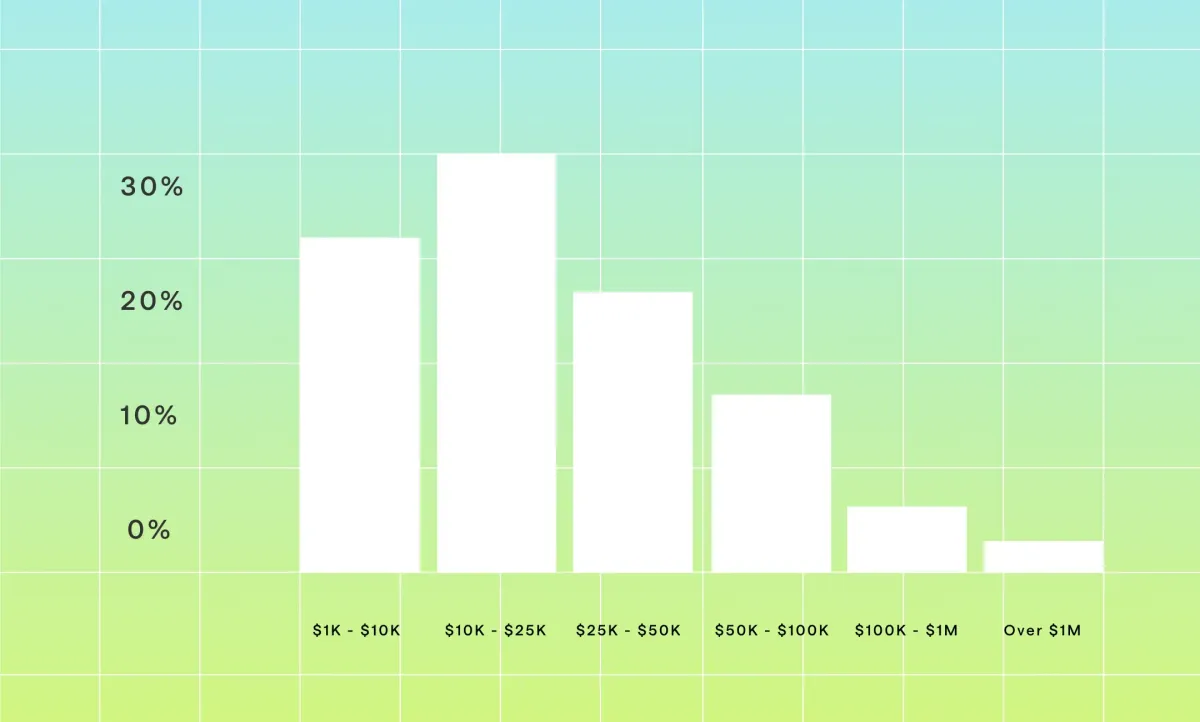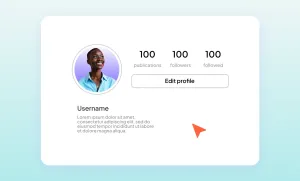Influencer marketing has exploded in the last few years, but behind the buzzwords and brand campaigns is a simple question a lot of people are starting to ask: how much money are influencers actually making?
Not just the big names with millions of followers, but the smaller creators too, the ones posting skincare tips, book recs, travel videos, or gym routines between day jobs.
For some, it’s a side hustle that covers groceries or rent. For others, it’s a full-time income that rivals what you’d make in medicine, law, or tech. While there’s no one-size-fits-all answer, there are patterns.
Let's take a look at how much influencers charge, how they actually get paid, and what kind of content opens the door to serious income in 2025.
Key Takeaways: How Much Influencers Make in 2025
- Influencer earnings vary by follower count, platform, and niche. Nano-influencers can make a few hundred dollars per post, while mega-influencers often earn $50,000 or more on platforms like YouTube, TikTok, and Instagram.
- There are five main influencer tiers, from nano (1K followers) to mega (1M+). Each tier offers different value to brands, from intimate engagement to massive reach and media impact.
- Instagram remains a top platform for sponsored posts, with TikTok close behind for its authenticity and viral reach. YouTube still commands the highest per-post rates thanks to its long-form, trust-based content.
- Influencers earn money through multiple streams, including brand deals, affiliate links, ad revenue, product sales, subscriptions, UGC licensing, and speaking gigs, not just sponsored posts.
- Brands work with influencers because trust drives conversions. Influencer content feels personal and targeted, often outperforming traditional ads in both engagement and ROI.
Types of Social Media Influencers
As influencer marketing continues to evolve, so does the way we classify influencers. Today, creators are typically grouped by their follower count, which often reflects not just their reach, but the kind of relationships they have with their audience, and the type of content they create. Below is a detailed look at the most widely recognized types of social media influencers as of 2025.
1. Nano-Influencers (1,000 - 10,000 followers)
Nano-influencers are the relatable voices of social media. With modest but highly engaged followings, these creators are often everyday people who share content centered on personal passions, local experiences, or niche interests. Their audiences tend to be tight-knit and trust their recommendations as they would a piece of advice from a close one. Nano-influencers are especially effective for community-based campaigns or hyper-local promotions. Their strength lies in authenticity and the ability to spark real conversations within small communities.
2. Micro-Influencers (10,000 - 100,000 followers)
Micro-influencers have carved out loyal followings by focusing on specific topics or niches, like skincare enthusiasts, tech reviewers, fitness coaches, or book lovers. With a broader reach than nano-influencers but still an intimate feel, micro-influencers are trusted for their expertise and consistency. Many of them have built their personal brands through a mix of informative and relatable content. For instance, a beauty micro-influencer might be known for detailed skincare reviews and regularly partner with emerging cosmetic brands.
3. Mid-Tier Influencers (100,000 - 500,000 followers)
Mid-tier influencers have moved beyond niche fame and into broader recognition. They often maintain a professional content strategy, collaborate with well-known brands, and may have teams assisting with content production. These influencers can command substantial reach and maintain solid engagement, especially when their audience trusts them as experts or lifestyle role models. At this level, influencers begin to blur the line between online creators and full-fledged digital entrepreneurs.
4. Macro-Influencers (500,000 - 1M followers)
Macro-influencers typically gained their large audiences through years of consistent content, viral moments, or platform crossovers. Some may have risen to fame through YouTube or reality TV before expanding their influence on platforms like Instagram and TikTok. With significant reach and polished aesthetics, they are often seen as lifestyle authorities. Their partnerships tend to be high-profile and include major campaigns, product launches, or ambassador roles.
5. Mega-Influencers and Celebrity Influencers (1M+ followers)
At the top of the social media pyramid are mega-influencers, creators with over a million followers. These are digital celebrities whose influence often extends beyond one platform. They include social media natives like Charli D’Amelio and Addison Rae, whose careers began on TikTok, as well as long-standing YouTubers like MrBeast. Mega-influencers are typically involved in brand campaigns, TV appearances, product collaborations, or even launching their own product lines. Their names carry serious weight, and while not every follower is deeply engaged, their reach can drive massive traffic and media buzz.
Although similar in size to mega-influencers, celebrity influencers differ in that their fame originates from traditional industries like music, film, sports, or television. This includes figures like Selena Gomez or David Beckham, who use their social media platforms to share glimpses of their personal lives, promote causes, or endorse global brands. Their posts can make headlines, and their influence stretches far beyond likes or shares; it taps into global fandoms and media narratives.
How Much Do Influencers Charge Per Post?
Not all influencers are created equal, and neither are their paychecks. In the fast-evolving world of influencer marketing, content creators are typically categorized by their follower count, which directly affects how much they can charge for a post, video, or campaign.
While rates vary depending on follower count, engagement, content quality, content type, and niche, there are some estimated pricing trends we can break down by platform.
How Much Do Influencers Make on Instagram?
Instagram remains one of the best platforms for many creators and brands, especially in fashion, beauty, lifestyle, and wellness. It’s visual, curated, and still highly effective for product discovery. In 2025, here’s what influencers are typically earning for a single sponsored Instagram post:
- Nano-Influencers: $100 - $2,000
- Micro-Influencers: $2,000 - $8,000
- Mid-Tier Influencers: $8,000 - $20,000
- Macro-Influencers: $20,000 - $45,000
- Mega or Celebrity Influencers: $45,000 +
How Much Do Influencers Make on TikTok?
TikTok’s short-form, viral-first format has made it the fastest-growing platform for influencers and advertisers alike. What it lacks in polish, it makes up for in authenticity, and brands are paying attention.
- Nano-Influencers: $50 - $2,000
- Micro-Influencers: $2,000 - $8,000
- Mid-Tier Influencers: $8,000 - $20,000
- Macro-Influencers: $20,000 - $45,000
- Mega or Celebrity Influencers: $45,000 +
How Much Do Influencers Make on YouTube?
YouTube remains the gold standard for long-form content and influencer authority. Audiences on YouTube are more likely to spend time watching and trusting the creators they follow. As a result, sponsored YouTube videos are often the most expensive content formats.
- Nano-Influencers: $1,000 - $2,500
- Micro-Influencers: $2,500 - $9,000
- Mid-Tier Influencers: $9,000 - $25,000
- Macro-Influencers: $25,000 - $50,000
- Mega or Celebrity Influencers: $50,000+
How Do Influencers Make Money?
For today’s social media influencers, content creation is more than just a passion project; it’s a whole career. From casual lifestyle creators to full-time digital entrepreneurs, influencers have built multiple income streams around their personal brand and audience. Here are the top ways social media influencers currently make money:
1. Sponsored Posts and Brand Deals
This is the most common revenue stream for influencers. Brands pay creators to feature their product or service in a post, Story, Reel, or video, because honestly, influencers can bring in more conversions than a single ad on social media or TV. These deals can be one-off collaborations or long-term partnerships, and payment often depends on follower count, niche, and engagement rate.
2. Affiliate Marketing
Influencers earn a commission when followers purchase products through their unique affiliate links or discount codes. It’s a popular method on Instagram Stories (with link stickers) and TikTok videos (with pinned comments or captions), and works well for promoting clothing, beauty products, tech gadgets, and anything else.
3. Platform Monetization (Ad Revenue and Bonuses)
Many platforms now pay influencers directly:
- YouTube offers ad revenue through its Partner Program.
- TikTok pays through the Creator Rewards Program.
- Instagram has experimented with bonus payments for Reels (in select regions). While not every creator qualifies, consistent posting and strong engagement can generate steady monthly income.
4. Selling Their Own Products
Influencers often create and sell their own products, this could be physical merchandise like apparel or tote bags, or digital goods like presets, templates, or fitness programs. Some even launch full brands (skincare, supplements, fashion) using their social media platforms as the primary marketing channel.
5. Subscription-Based Content
Platforms like Patreon allow influencers to charge followers a monthly fee in exchange for exclusive content. This might include behind-the-scenes clips, early access to content, or private livestreams and communities.
6. Content Licensing and UGC (User-Generated Content)
Sometimes influencers are hired not for their audience, but for their content creation skills. Brands will pay for usage rights to repurpose influencer-made videos and photos in ads, websites, or social media. This is called UGC, and it's especially popular with micro and mid-tier influencers.
7. Speaking Engagements and Appearances
Larger influencers are often invited to speak at industry events, panels, or brand activations, either in person or virtually. Their social presence helps attract audiences, and these gigs can add another layer of income (and credibility) to their brand.
Why Do Brands Work With Influencers?
Brands don’t work with influencers just because they have a lot of followers. They work with them because people actually listen to what they say. That kind of trust is hard to earn, and even harder to buy through traditional ads.
Here’s why this type of marketing keeps growing:
- People believe them. When an influencer recommends something, it doesn’t feel like a sales pitch. It feels like a suggestion from someone you follow for a reason. And that makes a difference.
- The content fits into real life. Instead of being interrupted by ads, the product is part of the story. Maybe it shows up in a morning routine, a travel video, or a quick review. Either way, it feels natural to watch.
- Their audiences are specific. Most creators talk to a clear group of people. Whether it’s new parents, skincare fans, students, or sneakerheads, they know who’s listening. And brands like that kind of focus.
- The results are fast and measurable. When the match is right, influencer content gets shared, saved, and clicked. Brands see traffic. They see sales. It’s not always perfect, but when it works, it works well.
- It makes brands feel closer. People tune out ads. But they pay attention to people they follow. That attention helps brands show up in a way that feels more honest and more human.
Create Influencer Videos with Podcastle
besides posting content, influencers nowadays are tasked with essentially running solo business. But creating high-quality videos every week takes time. With a smart video editor like Podcastle, you can cut your editing time in half and spend more of it on strategy, pitching, and actually growing your brand.
Here’s what you get with Podcastle:
- Instant resizer that changes the aspect ratio of your video for TikTok, Instagram, or YouTube in one click
- AI video and audio enhancement that cleans up your clips automatically
- Eye contact correction that keeps you locked in, even if you weren’t
- Over 1,000 AI voices for voiceovers, narration, or character content
- Free-to-use music and stock videos so you’re never starting from scratch
It’s built for creators who want to move quickly without giving up quality. Try Podcastle for free and see how much faster your next video comes together.








